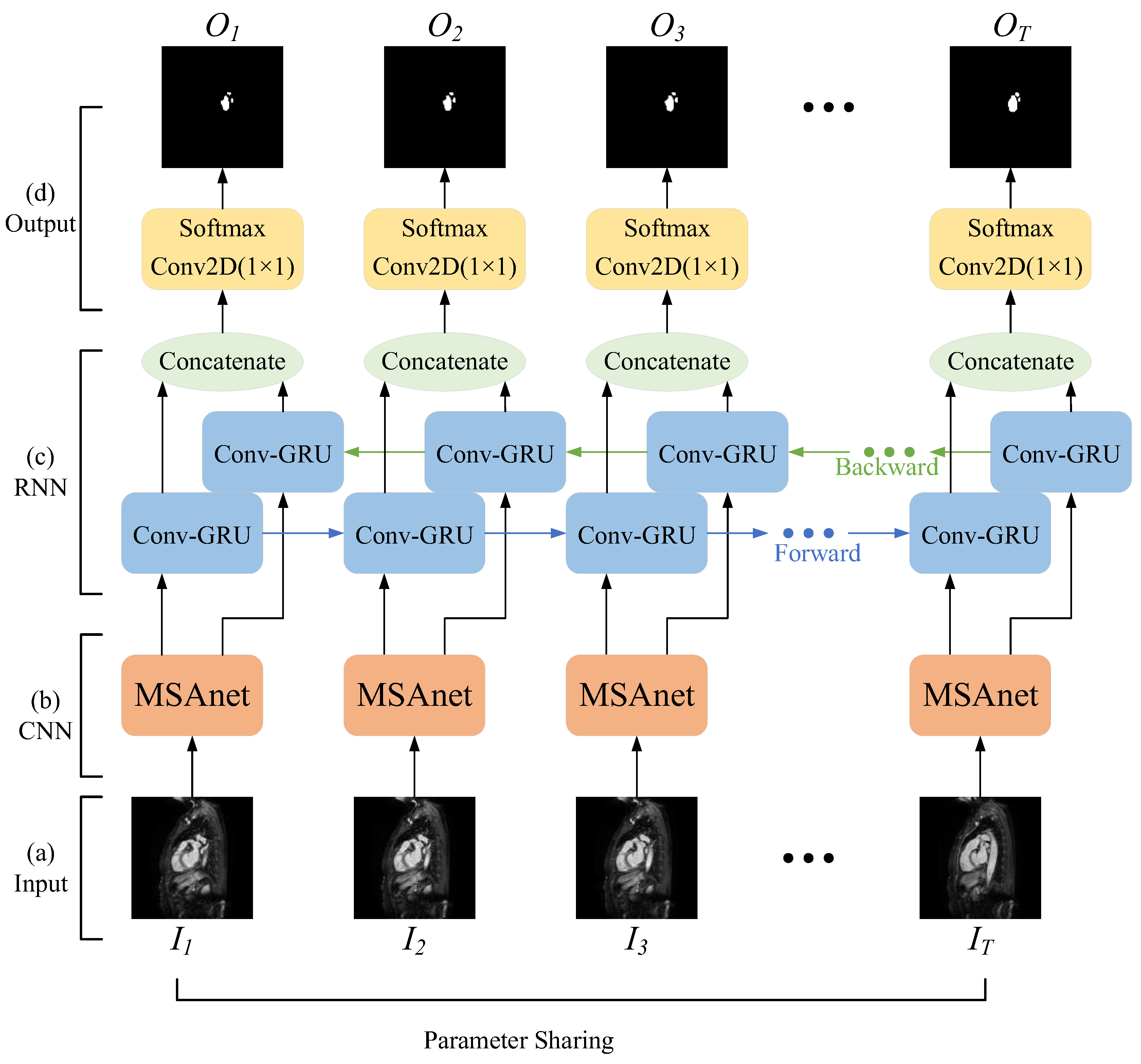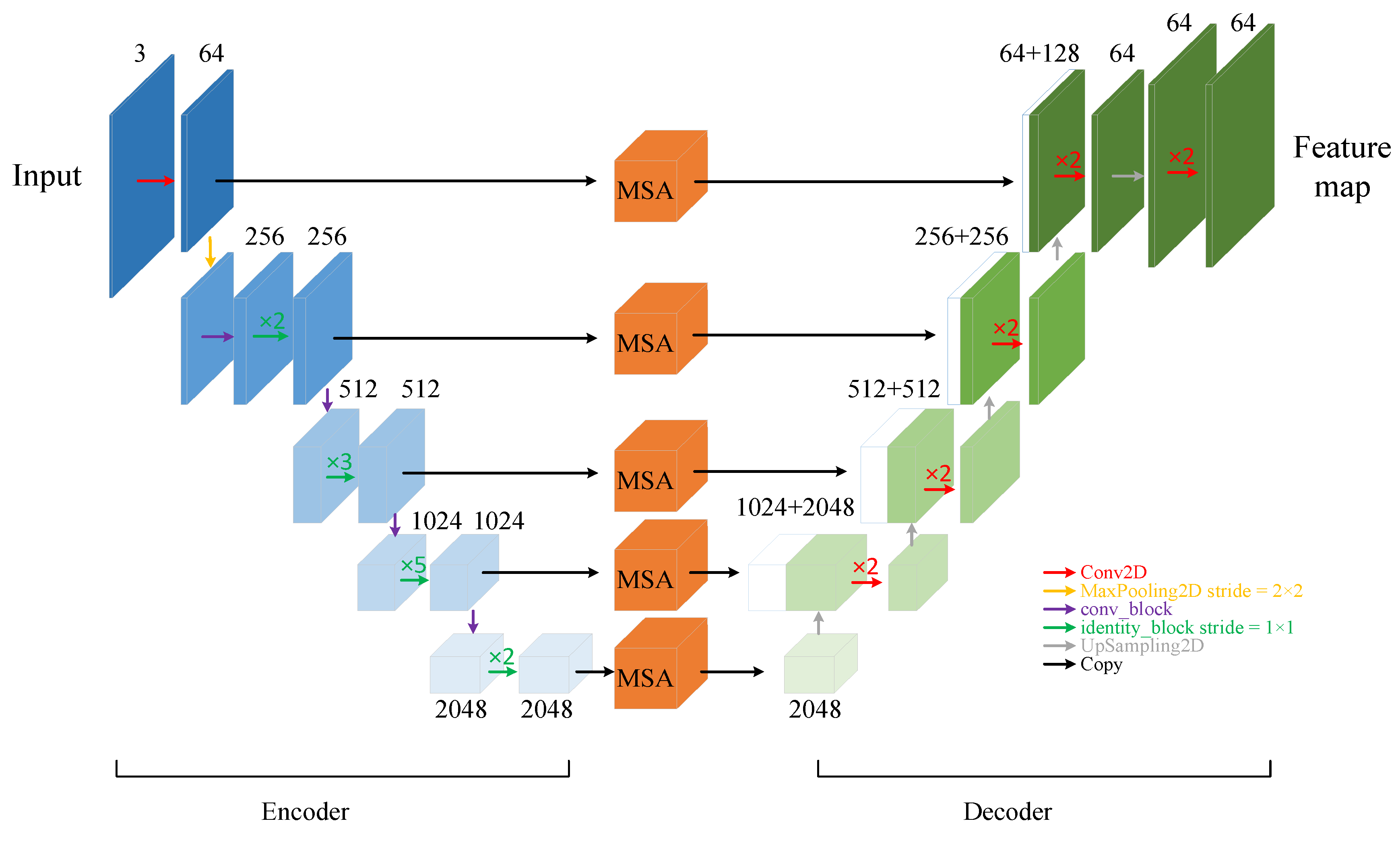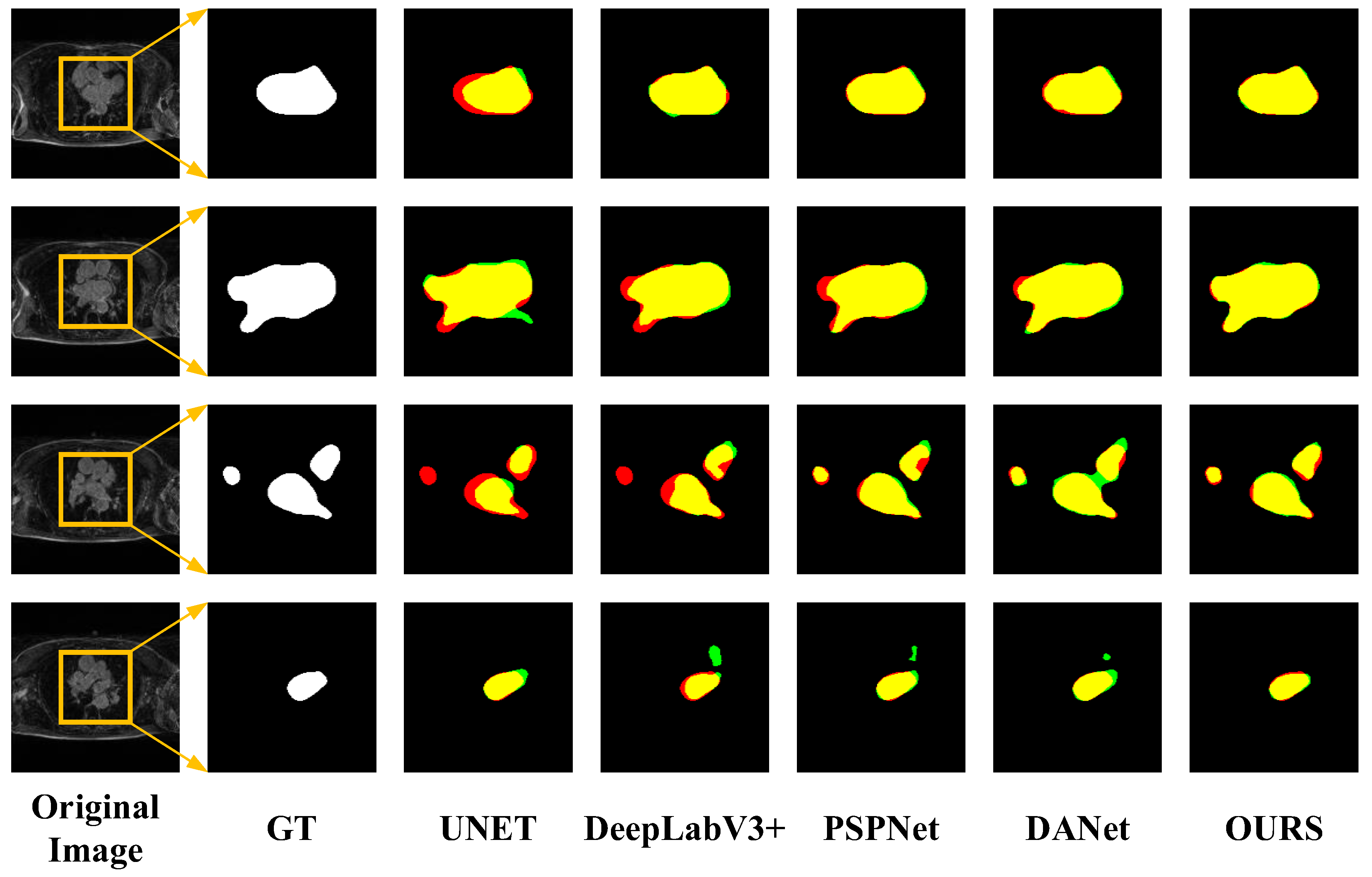Cardiac Magnetic Resonance Image Segmentation Method Based on Multi-Scale Feature Fusion and Sequence Relationship Learning
Abstract
1. Introduction
- (1)
- We propose a multiscale feature fusion attention module (MSA), which can capture correlations within spatial dimensions and within channel dimensions using attention mechanisms to enhance target features and improve the network’s ability to distinguish left atrial structures to achieve the capture of targets at different scales in the image.
- (2)
- We design a bidirectional convolutional GRU network, which can simulate the complete anterior-posterior continuous relationship between a set of sequential image slices and use it to obtain the correlation of left atrial structures in adjacent image slices.
- (3)
- We design a combined loss function that allows the network to focus more on the pixel points of the left atrial structure in the image and reduce the effect of positive and negative sample imbalance.
2. Cardiac MRI Image Segmentation Problem
- (1)
- Cardiac magnetic resonance images have sequential characteristics. Each set of images includes several two-dimensional image slices, and the left atrial structures contained in adjacent slices have continuity, so when extracting the left atrial structure of the current image slice, it is necessary to refer to the relevant information between the before and after image slices.
- (2)
- The left atrial structures in images have multi-scale characteristics. Due to the differences between individual patients and the special characteristics of the left atrial structure, the shape and size of the left atrial structure are not the same in each 2D image slice, and the scale difference is large. Single-scale feature extraction often loses spatial information and affects segmentation accuracy, so the use of multi-scale feature extraction needs to be considered.
- (3)
- The contrast between the left atrium and the surrounding tissue in the image is low. Cardiac MRI images contain not only the left atrial structures but also other structures of the heart, such as the right atrium and the right and left ventricles. These tissue structures have a small difference in pixel values, and the contrast is low, making the tissue structures difficult to distinguish in segmentation.
- (4)
- The percentage of pixel points of the left atrial structures in the images is relatively low. The left atrial pixel points in cardiac MRI images account for less than ten percent of the overall pixel points, and the rest are all background-like pixels. The difference in the number of pixel points between the target and the background is large, which results in a typical positive and negative sample imbalance problem.
3. Cardiac MRI Image Segmentation Method
- (1)
- Input layer: Firstly, the original images are split into a set of consecutive 2D images according to the MRI scanning direction; secondly, the image slices that do not contain the left atrial structure are removed and the image size is unified; finally, each set of cardiac MRI images is divided into several image sequences and input into the network.
- (2)
- Convolutional neural network layer with attention module: The features of the left atrial structure are extracted by the convolutional neural network, and then the correlation within the spatial dimension and the channel dimension is captured by the attention mechanism to strengthen the target features and improve the network’s ability to distinguish the left atrial structure to achieve the capture of targets at different scales in the image.
- (3)
- Recurrent neural network layer oriented to two-dimensional images: A bidirectional recurrent neural network with convolutional operations is used to simulate the complete anterior–posterior continuous relationship between a set of sequential image slices, and to obtain the correlation of left atrial structures in adjacent image slices.
- (4)
- Output layer: By constructing a combined loss function, the network is made to focus more on the pixel points of the left atrial structure in the image and reduce the effect of positive and negative sample imbalance. Finally, the class to which each pixel belongs is output to achieve the segmentation of the left atrial structure in cardiac MRI images.
3.1. Input Layer
3.2. Convolutional Neural Network Layer with Attention Module
3.2.1. U-Shaped Convolutional Neural Network
3.2.2. Multi-Scale Feature Fusion Attention Module
3.3. Recurrent Neural Network Layer Oriented to Two-Dimensional Images
3.3.1. Convolutional GRU Network
3.3.2. Bidirectional Convolutional GRU Network
3.4. Output Layer
4. Experimental Results and Analysis
4.1. Experimental Dataset
4.1.1. Left Atrial Segmentation Challenge Dataset (LASC2013)
4.1.2. Atrial Segmentation Challenge Dataset (ASC2018)
4.2. Experimental Setup
4.3. Experimental Results
4.3.1. Comparison Experiment between the Proposed Method and a Traditional Network
4.3.2. Network Validity Experiment
5. Conclusions
Author Contributions
Funding
Institutional Review Board Statement
Informed Consent Statement
Data Availability Statement
Conflicts of Interest
References
- Li, L.; Zimmer, V.A.; Schnabel, J.A.; Zhuang, X. Medical image analysis on left atrial LGE MRI for atrial fibrillation studies: A review. Med. Image Anal. 2022, 77, 102360. [Google Scholar] [CrossRef]
- An, L.; Wang, L.; Li, Y. HEA-Net: Attention and MLP Hybrid Encoder Architecture for Medical Image Segmentation. Sensors 2022, 22, 7024. [Google Scholar] [CrossRef] [PubMed]
- Liu, Y.; Han, G.; Liu, X. Lightweight Compound Scaling Network for Nasopharyngeal Carcinoma Segmentation from MR Images. Sensors 2022, 22, 5875. [Google Scholar] [CrossRef] [PubMed]
- Lee, H.M.; Kim, Y.J.; Kim, K.G. Segmentation Performance Comparison Considering Regional Characteristics in Chest X-ray Using Deep Learning. Sensors 2022, 22, 3143. [Google Scholar] [CrossRef] [PubMed]
- Chen, Y.; Wang, M.; Heidari, A.A.; Shi, B.; Hu, Z.; Zhang, Q.; Chen, H.; Mafarja, M.; Turabieh, H. Multi-threshold image segmentation using a multi-strategy shuffled frog leaping algorithm. Expert Syst. Appl. 2022, 194, 116511. [Google Scholar] [CrossRef]
- Liu, Z.; Jin, Y.; Li, Y. Synchronous enlargement algorithm for image segmentation in nuclear medicine. J. Tsinghua Univ. 2001, Z1, 17–20. [Google Scholar] [CrossRef]
- Yang, Y.; Wang, R.; Feng, C. Level set formulation for automatic medical image segmentation based on fuzzy clustering. Signal Process. Image Commun. 2020, 87, 115907. [Google Scholar] [CrossRef]
- Tobon-Gomez, C.; Geers, A.J.; Peters, J.; Weese, J.; Pinto, K.; Karim, R.; Ammar, M.; Daoudi, A.; Margeta, J.; Sandoval, Z.; et al. Benchmark for Algorithms Segmenting the Left Atrium From 3D CT and MRI Datasets. IEEE Trans. Med. Imaging 2015, 34, 1460–1473. [Google Scholar] [CrossRef]
- Li, L.; Zimmer, V.A.; Schnabel, J.A.; Zhuang, X.H. AtrialJSQnet: A New framework for joint segmentation and quantification of left atrium and scars incorporating spatial and shape information. Med. Image Anal. 2022, 76, 102303. [Google Scholar] [CrossRef]
- Liu, Y.; Zhu, M.; Wang, J.; Guo, X.; Yang, Y.; Wang, J. Multi-Scale Deep Neural Network Based on Dilated Convolution for Spacecraft Image Segmentation. Sensors 2022, 22, 4222. [Google Scholar] [CrossRef]
- Yin, X.H.; Wang, Y.C.; Li, D.Y. Suvery of medical image segmentation technology based on U-Net structure improvement. Ruan Jian Xue Bao J. Softw. 2021, 32, 519–550. Available online: http://www.jos.org.cn/1000-9825/6104.htm (accessed on 27 July 2020). (In Chinese).
- Liu, Y.; Dai, Y.; Yan, C.; Wang, K. Deep Learning Based Method for Left Atrial Segmentation in GE-MRI. In International Workshop on Statistical Atlases and Computational Models of the Heart; Springer: Berlin/Heidelberg, Germany, 2019. [Google Scholar]
- Xiong, Z.; Fedorov, V.V.; Fu, X.; Cheng, E.; Macleod, R.; Zhao, J. Fully Automatic Left Atrium Segmentation From Late Gadolinium Enhanced Magnetic Resonance Imaging Using a Dual Fully Convolutional Neural Network. IEEE Trans. Med. Imaging 2019, 38, 515–524. [Google Scholar] [CrossRef]
- Vesal, S.; Ravikumar, N.; Maier, A. Dilated Convolutions in Neural Networks for Left Atrial Segmentation in 3D Gadolinium Enhanced-MRI. In International Workshop on Statistical Atlases and Computational Models of the Heart; Springer: Berlin/Heidelberg, Germany, 2019. [Google Scholar]
- içek, Ö.; Abdulkadir, A.; Lienkamp, S.S.; Brox, T.; Ronneberger, O. 3D U-Net: Learning Dense Volumetric Segmentation from Sparse Annotation; Springer: Cham, Switzerland, 2016. [Google Scholar]
- Laiton-Bonadiez, C.; Sanchez-Torres, G.; Branch-Bedoya, J. Deep 3D Neural Network for Brain Structures Segmentation Using Self-Attention Modules in MRI Images. Sensors 2022, 22, 2559. [Google Scholar] [CrossRef] [PubMed]
- Nodirov, J.; Abdusalomov, A.B.; Whangbo, T.K. Attention 3D U-Net with Multiple Skip Connections for Segmentation of Brain Tumor Images. Sensors 2022, 22, 6501. [Google Scholar] [CrossRef]
- Gridach, M. PyDiNet: Pyramid Dilated Network for medical image segmentation. Neural Netw. 2021, 140, 274–281. [Google Scholar] [CrossRef] [PubMed]
- Wang, Y.; Gong, G.; Kong, D.; Li, Q.; Dai, J.; Zhang, H.; Qu, J.; Liu, X.; Xue, J. Pancreas segmentation using a dual-input v-mesh network. Med. Image Anal. 2021, 69, 101958. [Google Scholar] [CrossRef] [PubMed]
- Long, J.; Shelhamer, E.; Darrell, T. Fully Convolutional Networks for Semantic Segmentation. In Proceedings of the IEEE Conference on Computer Vision and Pattern Recognition, Boston, MA, USA, 7–12 June 2015; pp. 3431–3440. [Google Scholar]
- Ronneberger, O.; Fischer, P.; Brox, T. U-Net: Convolutional Networks for Biomedical Image Segmentation. In International Conference on Medical Image Computing and Computer-Assisted Intervention; Springer International Publishing: Berlin/Heidelberg, Germany, 2015. [Google Scholar]
- Chen, X.; Zhang, X.; Xie, H.; Tao, X.; Wang, F.L.; Xie, N.; Hao, T. A bibliometric and visual analysis of artificial intelligence technologies-enhanced brain MRI research. Multimed. Tools Appl. 2021, 80, 17335–17363. [Google Scholar] [CrossRef]
- Cao, P.; Sheng, Q.; Pan, Q.; Ning, G.; Wang, Z.; Fang, L. Combining Sequence Learning and U-Like-Net for Hippocampus Segmentation. J. Comput. Des. Comput. Graph. 2019, 31, 1382. [Google Scholar] [CrossRef]
- Zhao, H.; Shi, J.; Qi, X.; Wang, X.; Jia, J. Pyramid Scene Parsing Network. In Proceedings of the 2017 IEEE Conference on Computer Vision and Pattern Recognition, Honolulu, HI, USA, 21–26 July 2017. [Google Scholar]
- Chen, S.; Qiu, C.; Yang, W.; Zhang, Z. Multiresolution Aggregation Transformer UNet Based on Multiscale Input and Coordinate Attention for Medical Image Segmentation. Sensors 2022, 22, 3820. [Google Scholar] [CrossRef]
- He, K.; Zhang, X.; Ren, S.; Sun, J. Deep Residual Learning for Image Recognition. In Proceedings of the 2016 IEEE Conference on Computer Vision and Pattern Recognition (CVPR), Las Vegas, NV, USA, 27–30 June 2016. [Google Scholar]
- Yamanakkanavar, N.; Choi, J.Y.; Lee, B. Multiscale and Hierarchical Feature-Aggregation Network for Segmenting Medical Images. Sensors 2022, 22, 3440. [Google Scholar] [CrossRef] [PubMed]
- Fu, J.; Liu, J.; Tian, H.; Li, Y.; Bao, Y.; Fang, Z.; Lu, H. Dual Attention Network for Scene Segmentation. In Proceedings of the 2019 IEEE/CVF Conference on Computer Vision and Pattern Recognition (CVPR), Long Beach, CA, USA, 15–20 June 2019. [Google Scholar]
- Cho, K.; Merrienboer, B.V.; Gulcehre, C.; Bahdanau, D.; Bougares, F.; Schwenk, H.; Bengio, Y. Learning Phrase Representations using RNN Encoder-Decoder for Statistical Machine Translation. In Proceedings of the 2014 Conference on Empirical Methods in Natural Language Processing (EMNLP), Doha, Qatar, 25–29 October 2014. [Google Scholar]
- Ballas, N.; Yao, L.; Pal, C.; Courville, A.C. Delving Deeper into Convolutional Networks for Learning Video Representations. Comput. Sci. 2015, 1511, 06432. [Google Scholar]
- Bai, W.; Suzuki, H.; Qin, C.; Tarroni, G.; Oktay, O.; Matthews, P.M.; Rueckert, D. Recurrent Neural Networks for Aortic Image Sequence Segmentation with Sparse Annotations. In International Conference on Medical Image Computing and Computer-Assisted Intervention; Springer: Cham, Switzerland, 2018. [Google Scholar]
- Lin, T.; Goyal, P.; Girshick, R.; He, K.; Dollár, P. Focal loss for dense object detection. In Proceedings of the IEEE International Conference on Computer Vision (ICCV), Venice, Italy, 22–29 October 2017; pp. 2999–3007. [Google Scholar]
- Xiong, Z.; Xia, Q.; Hu, Z.; Huang, N.; Bian, C.; Zheng, Y.; Vesal, S.; Ravikumar, N.; Maier, A.; Yang, X.; et al. A global benchmark of algorithms for segmenting the left atrium from late gadolinium-enhanced cardiac magnetic resonance imaging. Med. Image Anal. 2021, 67, 101832. [Google Scholar] [CrossRef] [PubMed]
- Sudre, C.H.; Li, W.; Vercauteren, T.; Ourselin, S.; Cardoso, M.J. Generalised dice overlap as a deep learning loss function for highly unbalanced segmentations. In Deep Learning in Medical Image Analysis and Multimodal Learning for Clinical Decision Support; Springer: Cham, Switzerland, 2017; pp. 240–248. [Google Scholar]
- Huttenlocher, D.; Klanderman, G.; Rucklidge, W. Comparing images using the Hausdorff distance. IEEE Trans. Pattern Anal. Mach. Intell. 1993, 15, 850–863. [Google Scholar] [CrossRef]
- Chen, L.C.; Zhu, Y.; Papandreou, G.; Schroff, F.; Adam, H. Encoder-Decoder with Atrous Separable Convolution for Semantic Image Segmentation. In European Conference on Computer Vision; Springer: Cham, Switzerland, 2018. [Google Scholar]
- Loshchilov, I.; Hutter, F. Decoupled Weight Decay Regularization. arXiv 2017, arXiv:1711.05101. [Google Scholar]
- Kausar, A.; Razzak, I.; Shapiai, I.; Alshammari, R. An Improved Dense V-Network for Fast and Precise Segmentation of Left Atrium. In Proceedings of the 2021 International Joint Conference on Neural Networks (IJCNN), Shenzhen, China, 22 July 2021; pp. 1–8. [Google Scholar] [CrossRef]
- Pawan, S.; Jeevan, G.; Rajan, J. Semi-supervised structure attentive temporal mixup coherence for medical image segmentation. Biocybern. Biomed. Eng. 2022, 42, 1149–1161. [Google Scholar] [CrossRef]
- Uslu, F.; Varela, M.; Boniface, G.; Mahenthran, T.; Chubb, H.; Bharath, A.A. LA-Net: A Multi-Task Deep Network for the Segmentation of the Left Atrium. IEEE Trans. Med. Imaging 2021, 41, 456–464. [Google Scholar] [CrossRef]
- Luo, X.; Liao, W.; Chen, J.; Song, T.; Chen, Y.; Zhang, S.; Chen, N.; Wang, G.; Zhang, S. Efficient semi-supervised gross target volume of nasopharyngeal carcinoma segmentation via uncertainty rectified pyramid consistency. In International Conference on Medical Image Computing and Computer-Assisted Intervention; Springer: Cham, Switzerland, 2021; pp. 318–329. [Google Scholar]
- Wu, Y.; Ge, Z.; Zhang, D.; Xu, M.; Zhang, L.; Xia, Y.; Cai, J. Mutual consistency learning for semi-supervised medical image segmentation. Med. Image Anal. 2022, 81, 102530. [Google Scholar] [CrossRef]
- Zuluaga, M.A.; Cardoso, M.J.; Modat, M.; Ourselin, S. Multi-atlas propagation whole heart segmentation from MRI and CTA using a local normalised correlation coefficient criterion. In International Conference on Functional Imaging and Modeling of the Heart; Springer: Berlin/Heidelberg, Germany, 2013; pp. 174–181. [Google Scholar]
- Stender, B.; Blanck, O.; Wang, B.; Schlaefer, A. Model-based segmentation of the left atrium in CT and MRI scans. In International Workshop on Statistical Atlases and Computational Models of the Heart; Imaging and Modelling Challenges; Springer: Berlin, Germany, 2014; Volume 8330, pp. 31–41. [Google Scholar]
- Sandoval, Z.; Betancur, J.; Dillenseger, J.-L. Multi-atlas-based segmentation of the left atrium and pulmonary veins. In International Workshop on Statistical Atlases and Computational Models of the Heart; Imaging and Modelling Challenges; Springer: Berlin, Germany, 2014; Volume 8330, pp. 24–30. [Google Scholar]









| Methods | Strengths | Weaknesses |
|---|---|---|
| Traditional algorithms [5,6,7] | Achieve good results for specific problems | Require manual feature extraction |
| Yashu Liu et al. [12] | Reduce the effect of imbalance between positive and negative samples | Does not consider sequence relationships and low accuracy |
| Zhaohan Xiong et al. [13] | Extract multi-scale feature | Does not consider Sequence relationships |
| Sulaiman Vesal et al. [14] | Exploited Sequential relationships through 3D convolution | Require large datasets and difficult to capture long-range dependencies |
| OUR | Extract multi-scale features and capture sequence relationship | Require complex structure and high calculation volume |
| Dataset | Network | DICE (%) | IOU (%) | Hausdorff Distance (mm) |
|---|---|---|---|---|
| LASC2013 | U-Net (2015) [21] | 82.67 | 84.47 | 8.068 |
| PSPNet (2017) [24] | 84.42 | 85.95 | 7.049 | |
| DeepLabV3+ (2018) [36] | 85.93 | 86.48 | 6.819 | |
| DANet (2019) [28] | 88.27 | 87.46 | 6.118 | |
| Dense V-Net (2021) [38] | 84.03 | 72.46 | 6.430 | |
| ATMC (2022) [39] | 89.75 | 81.51 | 7.020 | |
| OURS | 90.73 | 89.37 | 4.803 | |
| ASC2018 | U-Net (2015) [21] | 84.38 | 85.33 | 13.533 |
| PSPNet (2017) [24] | 86.11 | 85.64 | 12.385 | |
| DeepLabV3+ (2018) [36] | 86.25 | 85.98 | 12.722 | |
| DANet (2019) [28] | 89.51 | 87.59 | 11.709 | |
| LA-Net (2021) [40] | 92.00 | 86.00 | 12.430 | |
| URPC (2021) [41,42] | 88.74 | 79.93 | 13.400 | |
| OURS | 92.05 | 89.41 | 9.056 |
| Methods | DICE (%) |
|---|---|
| Zuluaga et al. (2013) [43] | 92.00 |
| Stender et al. (2014) [44] | 87.06 |
| Sandoval et al. (2014) [45] | 94.20 |
| OURS | 90.73 |
| Dataset | Network | DICE (%) | IOU (%) | Hausdorff Distance (mm) |
|---|---|---|---|---|
| LASC2013 | RUNet | 83.49 | 85.43 | 7.767 |
| MUNet | 88.44 | 88.04 | 5.701 | |
| SeqUNet | 87.48 | 87.44 | 5.098 | |
| OURS | 90.73 | 89.37 | 4.803 | |
| ASC2018 | RUNet | 86.45 | 85.84 | 10.811 |
| MUNet | 89.13 | 87.56 | 10.124 | |
| SeqUNet | 88.69 | 87.42 | 10.719 | |
| OURS | 92.05 | 89.41 | 9.056 |
Disclaimer/Publisher’s Note: The statements, opinions and data contained in all publications are solely those of the individual author(s) and contributor(s) and not of MDPI and/or the editor(s). MDPI and/or the editor(s) disclaim responsibility for any injury to people or property resulting from any ideas, methods, instructions or products referred to in the content. |
© 2023 by the authors. Licensee MDPI, Basel, Switzerland. This article is an open access article distributed under the terms and conditions of the Creative Commons Attribution (CC BY) license (https://creativecommons.org/licenses/by/4.0/).
Share and Cite
Qi, Y.; Hu, C.; Zuo, L.; Yang, B.; Lv, Y. Cardiac Magnetic Resonance Image Segmentation Method Based on Multi-Scale Feature Fusion and Sequence Relationship Learning. Sensors 2023, 23, 690. https://doi.org/10.3390/s23020690
Qi Y, Hu C, Zuo L, Yang B, Lv Y. Cardiac Magnetic Resonance Image Segmentation Method Based on Multi-Scale Feature Fusion and Sequence Relationship Learning. Sensors. 2023; 23(2):690. https://doi.org/10.3390/s23020690
Chicago/Turabian StyleQi, Yushi, Chunhu Hu, Liling Zuo, Bo Yang, and Youlong Lv. 2023. "Cardiac Magnetic Resonance Image Segmentation Method Based on Multi-Scale Feature Fusion and Sequence Relationship Learning" Sensors 23, no. 2: 690. https://doi.org/10.3390/s23020690
APA StyleQi, Y., Hu, C., Zuo, L., Yang, B., & Lv, Y. (2023). Cardiac Magnetic Resonance Image Segmentation Method Based on Multi-Scale Feature Fusion and Sequence Relationship Learning. Sensors, 23(2), 690. https://doi.org/10.3390/s23020690





